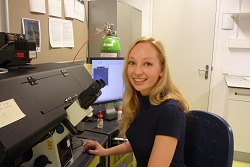Bacteria populations hedge their bets
Bacteria populations that can grow on two different sugars in turn display bet-hedging behaviour. This observation has enabled University of Groningen researchers to undermine the ‘adaptation theory’ favoured since Jacques Monod published it in 1949. The new Groningen theory was published in PNAS on 5 May 2014.
When bacteria grow in a medium with two different sugars, they first use the ‘tastiest’ sugar and then, after a short pause, the less-preferred sugar. The delay between the successive growth phases has been explained since a publication by Jacques Monod in 1949 as due to the bacteria having to adapt their metabolism. Monod was a French biochemist who was awarded the Nobel Prize for Medicine in 1965 as one of the discoverers of mRNA.
Textbooks
Over seventy years ago, Monod described the phenomenon of ‘diauxic growth’, the observation that when two different sugars are present, microbial cells first use up one sugar and then, after a short ‘lag phase’, switch to the other. Up till today, it was generally accepted that all cells in a population were involved in the further growth on the second carbohydrate. It was thought that they did this after a significant metabolic adaptation whereby the necessary enzymes were created during the lag phase. All over the world, biologists learned this explanation from their textbooks.
Subpopulation
Researchers from the departments of Molecular Genetics and Theoretical Biology of the University of Groningen, however, have demonstrated that not all of the cells continue to grow after the adaptation phase; rather only a subpopulation swings to action when the second sugar is the only carbohydrate remaining. In a culture of the bacterium Lactococcus lactis, two stable cell types with differing metabolic strategies emerged.
Bet-hedging behaviour
It thus appears that the bacteria are displaying betting behaviour – by producing different metabolic phenotypes they are clearly hedging their bets. The different cell types, which co-exist peacefully, have the same genotype but a different metabolic phenotype. Only one of these cell types is able to continue growing in the second phase. In evolutionary terms, it can be favourable for a population to contain different manifestations, even though this might cost extra energy. Changes in circumstances may require a previously suboptimally acting subpopulation to save the situation and ensure that the population continues to grow.
‘Second choice’ cellobiose
The research was mainly conducted by Ana Solopova, a PhD student in the molecular genetics group headed by Oscar Kuipers. She allowed L. lactis to grow on glucose mixtures in varying concentrations, and on cellobiose. She continually found that the population first grew exponentially on the glucose, and then after a short pause continued to grow on the ‘second choice’ cellobiose. She noticed that the more glucose there was in the growth medium, and thus the longer and better the population was able to grow before exhausting this initial food source, the longer it took for the growth on the cellobiose to get going.
Film
Solopova was also able to literally capture the diauxic growth process on film. She stained the cells growing on the cellobiose fluorescent green. Under the microscope, she could then follow the multiplication of the bacteria. As a result she could demonstrate that some of the cells remained black after the switch to the cellobiose source. They no longer multiplied, but did not die either – they ‘slept’. Solopova shows one of her films on her computer: ‘You see? The black ones are a bit fluffy. But they don’t die!’

Note for the press
- More information: Prof. Oscar Kuipers, Molecular Genetics, Groningen Biomolecular Sciences and Biotechnology Institute (GBB), University of Groningen.
- The article was published on 5 May in PNAS:
Bet-hedging during bacterial diauxic shift
Ana Solopova a, Jordi van Gestel b, Franz J. Weissing b,c, Herwig Bachmann d,e, Bas Teusink d,f, Jan Kok a,e, and Oscar P. Kuipers a,e,f,1
a Department of Molecular Genetics, Groningen Biomolecular Sciences and Biotechnology Institute, and b Theoretical Biology Group, Centre for Ecological and Evolutionary Studies, University of Groningen, 9747 AG, Groningen, The Netherlands; cSystems Biology Centre Groningen, University of Groningen, 9713 AV, Groningen, The Netherlands; d Faculty of Earth and Life Sciences, Systems Bioinformatics, Centre for Integrative Bioinformatics Vrije Universiteit/Netherlands Institute for Systems Biology, Vrije Universiteit Amsterdam, 1081 HV, Amsterdam, The Netherlands; e Top Institute Food and Nutrition, 6700 AN, Wageningen, The Netherlands; and f Kluyver Centre for Genomics of Industrial Fermentation, Groningen/Delft, The Netherlands
| Last modified: | 08 January 2024 08.51 a.m. |
More news
-
25 April 2024
Lineke Sneller appointed as Professor of Practice of Digitalization & AI in Accounting and Auditing
The Faculty of Economics and Business (FEB) is pleased to announce that as of 1 May, professor Lineke Sneller will be appointed as Professor Practice of Digitalization & AI in Accounting and Auditing. The chair is situated within the department of...
-
25 April 2024
Jenny van Doorn and co-authors receive 2024 Weitz-Winer-O’Dell Award
Jenny van Doorn and co-authors Martin Mende, Maura L. Scott (both Florida State University), Dhruv Grewal (Babson College) and Ilana Shanks (Stony Brook University) have won the 2024 Weitz-Winer-O’Dell Award. They received the award for their paper...
-
23 April 2024
Nine MSCA Doctoral Network grants for FSE researchers
Nine researchers of the Faculty of Science and Engineering have received a Horizon Europe Marie Sklodowska Curie Doctoral Network grant.
